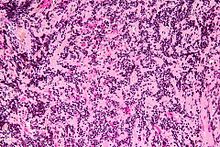| Pineocytoma | |
|---|---|
| Other names | Pinealocytoma |
 | |
| Micrograph of a pineocytoma. HPS stain. | |
| Specialty | Oncology |
| Symptoms | Parinaud syndrome, nausea, vision abnormalities, hydrocephalus, and headaches. |
| Usual onset | 20-60 years of age. |
| Diagnostic method | MRI and CT scan. |
| Differential diagnosis | Pineoblastoma, pineal cyst, germ cell tumors, and metastasis. |
| Treatment | Surgical excision. |
| Prognosis | 86% 5-year survival rate. |
Pineocytoma, is a rare, benign, slowly growing tumor of the pineal gland. The pineal gland is a small endocrine gland close to the center of the brain that secretes melatonin into the bloodstream. Pineocytomas can cause pressure and fluid build-up in the brain. They are more common in adults. Symptoms include vision problems, nausea, vomiting, memory problems, and headaches.
Signs and symptoms
Because of their massive growth, pineocytoma symptoms are related to increased intracranial pressure. Some common symptoms of pineocytomas include Parinaud syndrome, headaches, dizziness, papilledema, tremors, ataxia, impaired vision, ambulation, ptosis, nausea, and vomiting.
Causes
The true cause of pineocytomas is unknown. No genetic mutations have been linked to pineocytomas however, there have been some associations with certain chromosomal abnormalities. There are no known risk factors for pineocytomas.
Diagnosis
Pineocytomas typically present on a CT scan as round and well-delineated masses with a diameter under 3cm. Pineocytomas are homogeneous, hypodense, and sometimes have central or peripheral calcification. On an MRI a pineocytoma often appears isointense or hypointense in T1-weighted scans. However, they usually appear hyperintense on T2-weighted scans. The diagnosis of a pineocytoma is confirmed by a brain biopsy.
Management
The main treatment options for pineocytomas are gross total resection, subtotal resection, and radiation.
See also
References
- "National Organization for Rare Disorders". National Organization for Rare Disorders. June 16, 2022. Retrieved November 24, 2023.
- ^ Gaillard, Frank (January 7, 2022). "Radiology Reference Article". Radiopaedia. Retrieved November 24, 2023.
- "Pineocytoma". AdventHealth Neuroscience Institute. Retrieved November 24, 2023.
- ^ Moini, Jahangir; Badolato, Craig; Ahangari, Raheleh (2020). "Pineal Tumors". Epidemiology of Endocrine Tumors. Elsevier. pp. 201–214. doi:10.1016/b978-0-12-822187-7.00015-3. ISBN 9780128221877. S2CID 240653465. Retrieved November 24, 2023.
- Hsieh, Chi-Chih; Chen, Jui-Sheng (2022). "Radiotherapy After Endoscopic Biopsy in an Adult with Pineocytoma, the Rare Brain Tumor in an Adult: A Case Report and Literature Review". International Medical Case Reports Journal. 15. Informa UK Limited: 307–311. doi:10.2147/imcrj.s367293. ISSN 1179-142X. PMC 9215869. PMID 35755243.
External links
| Classification | D |
|---|---|
| External resources |
|